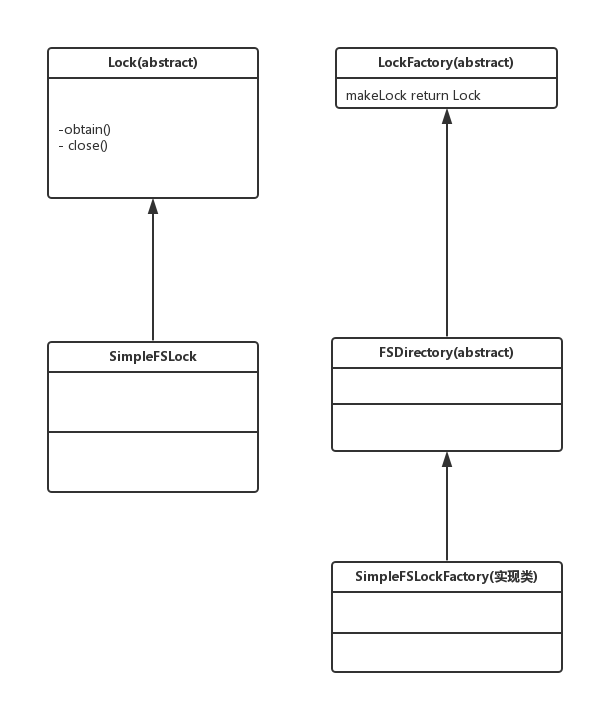大家都知道,在多线程或多进程的环境中,对统一资源的访问需要特别小心,特别是在写资源时,如果不加锁,将会导致很多严重的后果,Lucene的索引也是如此,lucene对索引的读写分为IndexReader和IndexWriter,顾名思义,一个读,一个写,lucene可以对同一个索引文件建立多个IndexReader对象,但是只能有一个IndexWriter对象,这是怎么做到的呢?显而易见是需要加锁的,加锁可以保证一个索引文件只能建立一个IndexWriter对象。下面就细说Lucene索引文件锁机制:
如果我们对同一个索引文件建立多个不同的IndexWriter会怎么样呢?
IndexWriterConfig indexWriterConfig = new IndexWriterConfig(analyzer); IndexWriter indexWriter = new IndexWriter(dir, indexWriterConfig); IndexWriterConfig indexWriterConfig2 = new IndexWriterConfig(analyzer); IndexWriter indexWriter2 = new IndexWriter(dir,indexWriterConfig2);
运行后,控制台输出:
Exception in thread "main" org.apache.lucene.store.LockObtainFailedException: Lock obtain timed out: NativeFSLock@C:UsersnewDesktopLucenewrite.lock at org.apache.lucene.store.Lock.obtain(Lock.java:89) at org.apache.lucene.index.IndexWriter.<init>(IndexWriter.java:755) at test.Index.index(Index.java:51) at test.Index.main(Index.java:78)
显然是不可以对同一个索引文件开启多个IndexWriter。

上面是一个比较简略的类图,可以看到lucene采用了工厂方法,这样可以方便扩展其他实现,这里只以SimpleFsLock为例说明lucene的锁机制(其他的有兴趣可以看lucene源码)。
Lock类是锁的基类,一个抽象类,源码如下:
public abstract class Lock implements Closeable { /** How long {@link #obtain(long)} waits, in milliseconds, * in between attempts to acquire the lock. */ public static long LOCK_POLL_INTERVAL = 1000; /** Pass this value to {@link #obtain(long)} to try * forever to obtain the lock. */ public static final long LOCK_OBTAIN_WAIT_FOREVER = -1; /** Attempts to obtain exclusive access and immediately return * upon success or failure. Use {@link #close} to * release the lock. * @return true iff exclusive access is obtained */ public abstract boolean obtain() throws IOException; /** * If a lock obtain called, this failureReason may be set * with the "root cause" Exception as to why the lock was * not obtained. */ protected Throwable failureReason; /** Attempts to obtain an exclusive lock within amount of * time given. Polls once per {@link #LOCK_POLL_INTERVAL} * (currently 1000) milliseconds until lockWaitTimeout is * passed. * @param lockWaitTimeout length of time to wait in * milliseconds or {@link * #LOCK_OBTAIN_WAIT_FOREVER} to retry forever * @return true if lock was obtained * @throws LockObtainFailedException if lock wait times out * @throws IllegalArgumentException if lockWaitTimeout is * out of bounds * @throws IOException if obtain() throws IOException */ public final boolean obtain(long lockWaitTimeout) throws IOException { failureReason = null; boolean locked = obtain(); if (lockWaitTimeout < 0 && lockWaitTimeout != LOCK_OBTAIN_WAIT_FOREVER) throw new IllegalArgumentException("lockWaitTimeout should be LOCK_OBTAIN_WAIT_FOREVER or a non-negative number (got " + lockWaitTimeout + ")"); long maxSleepCount = lockWaitTimeout / LOCK_POLL_INTERVAL; long sleepCount = 0; while (!locked) { if (lockWaitTimeout != LOCK_OBTAIN_WAIT_FOREVER && sleepCount++ >= maxSleepCount) { String reason = "Lock obtain timed out: " + this.toString(); if (failureReason != null) { reason += ": " + failureReason; } throw new LockObtainFailedException(reason, failureReason); } try { Thread.sleep(LOCK_POLL_INTERVAL); } catch (InterruptedException ie) { throw new ThreadInterruptedException(ie); } locked = obtain(); } return locked; } /** Releases exclusive access. */ public abstract void close() throws IOException; /** Returns true if the resource is currently locked. Note that one must * still call {@link #obtain()} before using the resource. */ public abstract boolean isLocked() throws IOException; /** Utility class for executing code with exclusive access. */ public abstract static class With { private Lock lock; private long lockWaitTimeout; /** Constructs an executor that will grab the named lock. */ public With(Lock lock, long lockWaitTimeout) { this.lock = lock; this.lockWaitTimeout = lockWaitTimeout; } /** Code to execute with exclusive access. */ protected abstract Object doBody() throws IOException; /** Calls {@link #doBody} while <i>lock</i> is obtained. Blocks if lock * cannot be obtained immediately. Retries to obtain lock once per second * until it is obtained, or until it has tried ten times. Lock is released when * {@link #doBody} exits. * @throws LockObtainFailedException if lock could not * be obtained * @throws IOException if {@link Lock#obtain} throws IOException */ public Object run() throws IOException { boolean locked = false; try { locked = lock.obtain(lockWaitTimeout); return doBody(); } finally { if (locked) { lock.close(); } } } } }
里面最重要的方法就是obtain(),这个方法用来维持锁,建立锁之后,维持时间为LOCK_POLL_INTERVAL,之后需要重新申请维持锁,这样做是为了支持多线程读写。当然也可以将lockWaitTimeout设置为-1,这样就是一直维持写锁。
抽象基类LockFactory,只定义了一个抽象方法makeLock,返回Lock对象的一个实例。
public abstract class LockFactory { /** * Return a new Lock instance identified by lockName. * @param lockName name of the lock to be created. */ public abstract Lock makeLock(Directory dir, String lockName); }
抽象类FSLockFactory继承Lock:
public abstract class FSLockFactory extends LockFactory { /** Returns the default locking implementation for this platform. * This method currently returns always {@link NativeFSLockFactory}. */ public static final FSLockFactory getDefault() { return NativeFSLockFactory.INSTANCE; } @Override public final Lock makeLock(Directory dir, String lockName) { if (!(dir instanceof FSDirectory)) { throw new UnsupportedOperationException(getClass().getSimpleName() + " can only be used with FSDirectory subclasses, got: " + dir); } return makeFSLock((FSDirectory) dir, lockName); } /** Implement this method to create a lock for a FSDirectory instance. */ protected abstract Lock makeFSLock(FSDirectory dir, String lockName); }
可以看到
public static final FSLockFactory getDefault() {
return NativeFSLockFactory.INSTANCE;
}
这个方法默认返回NativeFSLockFactory,和SimpleFSLockFactory一样是一个具体实现,NativeFSLockFactory使用的是nio中FileChannel.tryLock方法,这里不展开讨论,有兴趣的读者可以去看jdk nio的源码(好像现在oracle不提供FileChannel实现类的源码了,需要去jvm里找)。
下面就是本篇文章的重头戏,SimpleFSLockFactory
public final class SimpleFSLockFactory extends FSLockFactory { /** * Singleton instance */ public static final SimpleFSLockFactory INSTANCE = new SimpleFSLockFactory(); private SimpleFSLockFactory() {} @Override protected Lock makeFSLock(FSDirectory dir, String lockName) { return new SimpleFSLock(dir.getDirectory(), lockName); } static class SimpleFSLock extends Lock { Path lockFile; Path lockDir; public SimpleFSLock(Path lockDir, String lockFileName) { this.lockDir = lockDir; lockFile = lockDir.resolve(lockFileName); } @Override public boolean obtain() throws IOException { try { Files.createDirectories(lockDir); Files.createFile(lockFile); return true; } catch (IOException ioe) { // On Windows, on concurrent createNewFile, the 2nd process gets "access denied". // In that case, the lock was not aquired successfully, so return false. // We record the failure reason here; the obtain with timeout (usually the // one calling us) will use this as "root cause" if it fails to get the lock. failureReason = ioe; return false; } } @Override public void close() throws LockReleaseFailedException { // TODO: wierd that clearLock() throws the raw IOException... try { Files.deleteIfExists(lockFile); } catch (Throwable cause) { throw new LockReleaseFailedException("failed to delete " + lockFile, cause); } } @Override public boolean isLocked() { return Files.exists(lockFile); } @Override public String toString() { return "SimpleFSLock@" + lockFile; } } }
在SimpleFSLockFactory定义了一个内部类SimpleFSLock继承Lock,我们还是主要看SimpleFSLockFactory的obtain方法,这里就是SimpleFSLock具体实现文件锁的代码。
Files.createDirectories(lockDir);
Files.createFile(lockFile);
可以看着两行代码,createDirectories建立write.lock(可以是别的文件名,lucene默认使用write.lock)文件所在的文件夹及父文件夹。createFile则是创建write.lock文件,这里有一个精妙的地方,如果write.lock已经存在,那么createFile则会抛出异常,如果抛出异常,则表明SimpleFSLockFactory维持文件锁失败,也即意味着别的进程正在写索引文件。
看到close()方法中Files.deleteIfExists(lockFile); 就表示如果每次关闭IndexWriter,则会删除write.lock文件。
总结一下,SimpleFSLockFactory加文件锁的机制可以通俗的理解为,在索引文件所在的目录下,创建一个write.lock文件,如果此文件夹下已经有write.lock文件,则表明已经有其他进程在写当前的索引目录,所以此次添加文件锁失败,也即不能像索引文件中添加信息。每次添加完信息后,则会删除write.lock文件,释放文件锁。也即如果write.lock文件存在,就表明已经有进程在写索引文件,如果write.lock不存在就创建文件并添加了文件锁,别的进程不能写文件。
这是一个非常精妙的方式去实现写文件锁,当然可能有些读者会疑惑为什么自己在Demo中,创建完索引,close后还有write.lock文件存在,因为现在lucene的默认实现是NativeFSLockFactory,也是上文提及的使用nio调用本地方法去实现的lock。